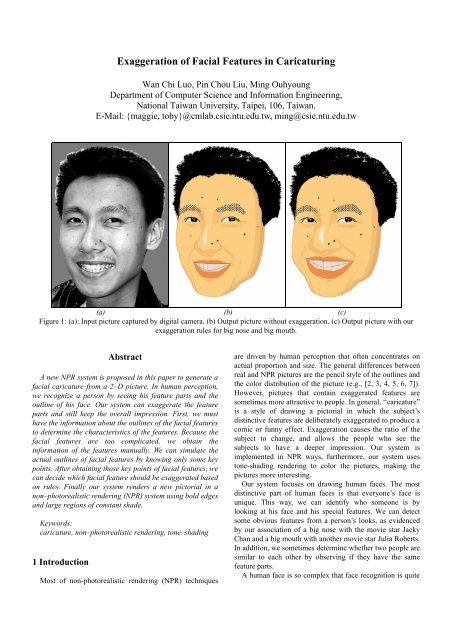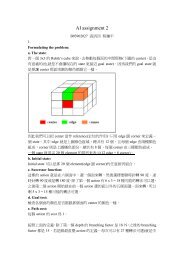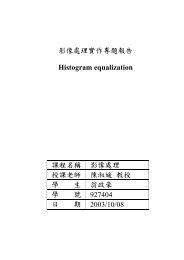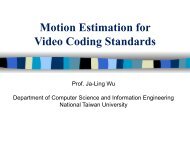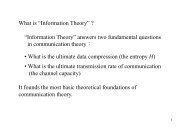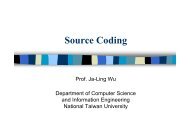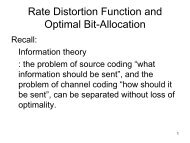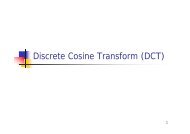Exaggeration of Facial Features in Caricaturing
Exaggeration of Facial Features in Caricaturing
Exaggeration of Facial Features in Caricaturing
Create successful ePaper yourself
Turn your PDF publications into a flip-book with our unique Google optimized e-Paper software.
<strong>Exaggeration</strong> <strong>of</strong> <strong>Facial</strong> <strong>Features</strong> <strong>in</strong> Caricatur<strong>in</strong>g<br />
Wan Chi Luo, P<strong>in</strong> Chou Liu, M<strong>in</strong>g Ouhyoung<br />
Department <strong>of</strong> Computer Science and Information Eng<strong>in</strong>eer<strong>in</strong>g,<br />
National Taiwan University, Taipei, 106, Taiwan.<br />
E-Mail: {maggie, toby}@cmlab.csie.ntu.edu.tw, m<strong>in</strong>g@csie.ntu.edu.tw<br />
(a) (b) (c)<br />
Figure 1: (a): Input picture captured by digital camera. (b) Output picture without exaggeration. (c) Output picture with our<br />
exaggeration rules for big nose and big mouth.<br />
Abstract<br />
A new NPR system is proposed <strong>in</strong> this paper to generate a<br />
facial caricature from a 2–D picture. In human perception,<br />
we recognize a person by see<strong>in</strong>g his feature parts and the<br />
outl<strong>in</strong>e <strong>of</strong> his face. Our system can exaggerate the feature<br />
parts and still keep the overall impression. First, we must<br />
have the <strong>in</strong>formation about the outl<strong>in</strong>es <strong>of</strong> the facial features<br />
to determ<strong>in</strong>e the characteristics <strong>of</strong> the features. Because the<br />
facial features are too complicated, we obta<strong>in</strong> the<br />
<strong>in</strong>formation <strong>of</strong> the features manually. We can simulate the<br />
actual outl<strong>in</strong>es <strong>of</strong> facial features by know<strong>in</strong>g only some key<br />
po<strong>in</strong>ts. After obta<strong>in</strong><strong>in</strong>g those key po<strong>in</strong>ts <strong>of</strong> facial features, we<br />
can decide which facial feature should be exaggerated based<br />
on rules. F<strong>in</strong>ally our system renders a new pictorial <strong>in</strong> a<br />
non–photorealistic render<strong>in</strong>g (NPR) system us<strong>in</strong>g bold edges<br />
and large regions <strong>of</strong> constant shade.<br />
Keywords:<br />
caricature, non–photorealistic render<strong>in</strong>g, tone–shad<strong>in</strong>g<br />
1 Introduction<br />
Most <strong>of</strong> non-photorealistic render<strong>in</strong>g (NPR) techniques<br />
are driven by human perception that <strong>of</strong>ten concentrates on<br />
actual proportion and size. The general differences between<br />
real and NPR pictures are the pencil style <strong>of</strong> the outl<strong>in</strong>es and<br />
the color distribution <strong>of</strong> the picture (e.g., [2, 3, 4, 5, 6, 7]).<br />
However, pictures that conta<strong>in</strong> exaggerated features are<br />
sometimes more attractive to people. In general, “caricature”<br />
is a style <strong>of</strong> draw<strong>in</strong>g a pictorial <strong>in</strong> which the subject’s<br />
dist<strong>in</strong>ctive features are deliberately exaggerated to produce a<br />
comic or funny effect. <strong>Exaggeration</strong> causes the ratio <strong>of</strong> the<br />
subject to change, and allows the people who see the<br />
subjects to have a deeper impression. Our system is<br />
implemented <strong>in</strong> NPR ways, furthermore, our system uses<br />
tone-shad<strong>in</strong>g render<strong>in</strong>g to color the pictures, mak<strong>in</strong>g the<br />
pictures more <strong>in</strong>terest<strong>in</strong>g.<br />
Our system focuses on draw<strong>in</strong>g human faces. The most<br />
dist<strong>in</strong>ctive part <strong>of</strong> human faces is that everyone’s face is<br />
unique. This way, we can identify who someone is by<br />
look<strong>in</strong>g at his face and his special features. We can detect<br />
some obvious features from a person’s looks, as evidenced<br />
by our association <strong>of</strong> a big nose with the movie star Jacky<br />
Chan and a big mouth with another movie star Julia Roberts.<br />
In addition, we sometimes determ<strong>in</strong>e whether two people are<br />
similar to each other by observ<strong>in</strong>g if they have the same<br />
feature parts.<br />
A human face is so complex that face recognition is quite
difficult. Therefore, our system has to f<strong>in</strong>d out the features’<br />
<strong>in</strong>formation by manually mark<strong>in</strong>g the feature po<strong>in</strong>ts.<br />
Mark<strong>in</strong>g those po<strong>in</strong>ts is very easy because users only need to<br />
<strong>in</strong>dicate a few key po<strong>in</strong>ts <strong>in</strong> the <strong>in</strong>put picture. From those<br />
key po<strong>in</strong>ts, our system can simulate the outl<strong>in</strong>es <strong>of</strong> features<br />
by connect<strong>in</strong>g the key po<strong>in</strong>ts <strong>in</strong> the form <strong>of</strong> a Bezier curve.<br />
Then, our system generates the output by apply<strong>in</strong>g our<br />
exaggeration rules and color<strong>in</strong>g <strong>in</strong> tone-shad<strong>in</strong>g. It deserves<br />
to be mentioned that users can <strong>in</strong>teract with our system to<br />
adjust the degree <strong>of</strong> exaggeration.<br />
A common usage <strong>of</strong> various styles <strong>of</strong> caricatur<strong>in</strong>g is seen<br />
<strong>in</strong> political comics. Draw<strong>in</strong>g those politicians or movie stars<br />
with deliberate exaggeration together with funny<br />
conversation always makes people laugh. Our system has<br />
advantages <strong>in</strong> help<strong>in</strong>g people who are not good at draw<strong>in</strong>g to<br />
generate funny caricatures <strong>in</strong> a short time, or help<strong>in</strong>g artists<br />
to quickly generate basic caricatures, which can be ref<strong>in</strong>ed<br />
afterward.<br />
In the rema<strong>in</strong>der <strong>of</strong> this paper, we describe our method <strong>of</strong><br />
exaggeration <strong>in</strong> Section 2 and the details <strong>of</strong> our system<br />
implementation <strong>in</strong> Section 3.<br />
2 <strong>Facial</strong> <strong>Exaggeration</strong>s<br />
In order to be able to identify who is <strong>in</strong> the pictorial <strong>in</strong><br />
which the face’s dist<strong>in</strong>ctive features are deliberately<br />
exaggerated, the whole ratio <strong>of</strong> the objective face cannot be<br />
changed. For example, a round face cannot be exaggerated<br />
to a th<strong>in</strong> face, and the ratio <strong>of</strong> the center <strong>of</strong> the eye to the rest<br />
<strong>of</strong> the face cannot be changed.<br />
So, we can only exaggerate features without destroy<strong>in</strong>g<br />
the whole ratio <strong>of</strong> the face. If we feel that the eyes are big,<br />
we can exaggerate them by us<strong>in</strong>g the <strong>in</strong>ner corner <strong>of</strong> the eye<br />
as the central po<strong>in</strong>t and <strong>in</strong>creas<strong>in</strong>g the size proportionally. If<br />
we feel that the nose is big, we can exaggerate it by us<strong>in</strong>g<br />
the bottom <strong>of</strong> the nose as the central po<strong>in</strong>t and <strong>in</strong>creas<strong>in</strong>g the<br />
size proportionally. In an extreme case, the adjusted nose<br />
becomes so big that it covers part <strong>of</strong> the mouth.<br />
2.1 Rules for the Face<br />
There are some features <strong>of</strong> our face, such as the forehead,<br />
cheekbone, jaw, and whole shape… etc. There are three rules<br />
for the face:<br />
Rule 1: If someone’s forehead is taller / shorter, we<br />
<strong>in</strong>crease / decrease the distance between the hairl<strong>in</strong>e and the<br />
brow.<br />
Rule 2: If someone’s cheekbone is bigger / smaller, we<br />
move the control po<strong>in</strong>ts <strong>of</strong> the cheekbone to change the<br />
curvature <strong>of</strong> the cheekbone and emphasize the characteristic.<br />
Rule 3: If someone has long jaw, we lengthen the jaw.<br />
2.2 Rules for the Eyes<br />
There are two characteristics <strong>of</strong> our eyes, the size and the<br />
shape. These two characteristics are <strong>in</strong>dependent from each<br />
other. There are two rules for the eyes:<br />
Rule 1: If the eyes are bigger or smaller, we change the<br />
size <strong>of</strong> them by keep<strong>in</strong>g the distance between the <strong>in</strong>ner<br />
corners <strong>of</strong> the two eyes the same.<br />
Rule 2: If the eyes are like some k<strong>in</strong>d <strong>of</strong> shape, we<br />
enlarge the angle between the eye and the horizontal l<strong>in</strong>e by<br />
keep<strong>in</strong>g the positions <strong>of</strong> the eyes’ <strong>in</strong>ner corners the same<br />
2.3 Rules for the Nose<br />
There are several characteristics <strong>of</strong> our nose, such as size<br />
and shape, etc. There are three rules for the nose:<br />
Rule 1: If the nose is big, we enlarge the size <strong>of</strong> the nose<br />
by us<strong>in</strong>g the bottom <strong>of</strong> the nose as the central po<strong>in</strong>t.<br />
Enlarg<strong>in</strong>g the size may cause the nose to cover part <strong>of</strong> the<br />
mouth.<br />
Rule 2: If the nose is hook-nosed, we make the nose tip<br />
lower and keep the other parts <strong>of</strong> nose the same. On the<br />
contrary, if the nose is snub-nosed, we make the nose tip<br />
higher.<br />
Rule 3: If the nose is high-bridged, we can bend the<br />
bridge <strong>of</strong> the nose to emphasize this characteristic.<br />
2.4 Rules for the Mouth<br />
Our mouth consists <strong>of</strong> two lips, the upper lip and the<br />
lower lip. Therefore, we can consider three characteristics:<br />
the shape <strong>of</strong> the whole mouth, the thickness <strong>of</strong> the upper lip,<br />
and the thickness <strong>of</strong> lower lip. It is easier to emphasize the<br />
thickness <strong>of</strong> the upper and lower lips rather than the shape <strong>of</strong><br />
the whole mouth. We have to consider two directions,<br />
horizontal and vertical, <strong>in</strong>dependently to emphasize the<br />
shape. Therefore, there are two rules for the mouth:<br />
Rule 1: If the lips are thick or th<strong>in</strong>, we emphasize the<br />
thickness <strong>of</strong> the upper and lower lips <strong>in</strong>dependently.<br />
Rule 2: If the mouth is big or small, we exaggerate the<br />
shape <strong>of</strong> the mouth by consider<strong>in</strong>g two directions, horizontal<br />
and vertical, <strong>in</strong>dependently.
3 System Implementation<br />
3.1 Input Picture<br />
Input Picture<br />
Manually Mark<strong>in</strong>g<br />
Decide Exaggerated<br />
<strong>Facial</strong> <strong>Features</strong><br />
<strong>Exaggeration</strong><br />
Layer Render<strong>in</strong>g<br />
Result<br />
Figure 2. System flow chart<br />
Our system needs a digital picture <strong>of</strong> a human face as its<br />
<strong>in</strong>put file. While we are tak<strong>in</strong>g that picture, the model’s face<br />
must be turned toward his right side about forty-five degrees.<br />
The reason is that the features are more three-D at this angle,<br />
especially the nose, and so will make exaggerated features<br />
pop up. If the model’s face faces us directly, we won’t know<br />
whether his or her nose is snub-nosed or not, whether his or<br />
her cheekbone is prom<strong>in</strong>ent or not, etc.<br />
3.2 Manually Mark<strong>in</strong>g<br />
In fetch<strong>in</strong>g the <strong>in</strong>formation <strong>of</strong> facial features, such as the<br />
shape and the position, we manually mark key po<strong>in</strong>ts on the<br />
<strong>in</strong>put picture. We separate those facial features <strong>in</strong>to seven<br />
parts: the right brow, the left brow, the right eye, the left eye,<br />
the nose, the mouth, and the rest <strong>of</strong> face. The outl<strong>in</strong>e <strong>of</strong> each<br />
part is composed <strong>of</strong> several key po<strong>in</strong>ts. For <strong>in</strong>stance, we<br />
need seventeen key po<strong>in</strong>ts to constitute the outl<strong>in</strong>e <strong>of</strong> a face<br />
and we need eleven key po<strong>in</strong>ts to constitute the outl<strong>in</strong>e <strong>of</strong> a<br />
mouth.<br />
Take a right eye for example. After a user manually marks<br />
the twelve key po<strong>in</strong>ts <strong>of</strong> the eye, our system can draw the<br />
outl<strong>in</strong>e <strong>of</strong> a right eye by connect<strong>in</strong>g them <strong>in</strong> the form <strong>of</strong> a<br />
Bezier curve. An example <strong>of</strong> the key po<strong>in</strong>ts <strong>of</strong> a right eye is<br />
shown <strong>in</strong> Figure 3. Each pair <strong>of</strong> neighbor<strong>in</strong>g po<strong>in</strong>ts<br />
constructs a Bezier curve. We have found the basic rules <strong>of</strong><br />
every <strong>in</strong>dividual Bezier curve so that the result is close to the<br />
actual outl<strong>in</strong>e no matter what k<strong>in</strong>d <strong>of</strong> right eyes are<br />
simulated.<br />
We choose the way <strong>of</strong> connect<strong>in</strong>g key po<strong>in</strong>ts <strong>in</strong>stead <strong>of</strong><br />
trac<strong>in</strong>g along the actual outl<strong>in</strong>e. The reason is that it is faster<br />
and easier to manipulate later. When we want to change the<br />
shape <strong>of</strong> the right eye, we only need to recalculate those key<br />
po<strong>in</strong>ts’ locations and apply the same functions <strong>of</strong> the Bezier<br />
curve. But if we choose to trace along the actual outl<strong>in</strong>e,<br />
every time we want to change the shape, we have to<br />
recalculate the whole function <strong>of</strong> the Bezier curve. It will<br />
take a lot <strong>of</strong> time and is too complicated.<br />
Figure 3. Left: Orig<strong>in</strong>al pictures. Right: Marked with key po<strong>in</strong>ts (yellow, blue) and control po<strong>in</strong>ts (red).
Figure 4. Left: Orig<strong>in</strong>al pictures. Right: Marked with key po<strong>in</strong>ts (yellow, blue) and control po<strong>in</strong>ts (red).<br />
3.3 <strong>Facial</strong> <strong>Features</strong> Draw<strong>in</strong>g<br />
We have mentioned that each pair <strong>of</strong> neighbor<strong>in</strong>g po<strong>in</strong>ts<br />
has its own function <strong>of</strong> the Bezier curve. These functions are<br />
very simple but their result can simulate those actual<br />
outl<strong>in</strong>es very closely. We know that a curve is completely<br />
def<strong>in</strong>ed by four po<strong>in</strong>ts – known as control po<strong>in</strong>ts – p0, p1, p2<br />
and p3. Because p0 is the start<strong>in</strong>g po<strong>in</strong>t and p1 is the end<br />
po<strong>in</strong>t, we set the pair <strong>of</strong> po<strong>in</strong>ts as p0 and p3. We separate the<br />
<strong>in</strong>terval between p0 and p3 <strong>in</strong>to 3x3 equal parts so that p1<br />
and p2 are always at the boundaries depend<strong>in</strong>g on different<br />
circumstances. An example <strong>of</strong> the control po<strong>in</strong>ts <strong>of</strong> a right<br />
eye is shown <strong>in</strong> Figure 4.<br />
3.4 Hair Draw<strong>in</strong>g<br />
Draw<strong>in</strong>g hair is one <strong>of</strong> the important parts <strong>of</strong> our system<br />
because a face without hair is not natural. Users can <strong>in</strong>dicate<br />
four po<strong>in</strong>ts to let our system know where the hair is. Those<br />
four po<strong>in</strong>ts are respectively responsible for the locations <strong>of</strong><br />
upper–right, upper–left, lower–right, and lower–left.<br />
Beg<strong>in</strong>n<strong>in</strong>g with those four po<strong>in</strong>ts, we f<strong>in</strong>d black hair by the<br />
bread-first search (BFS) algorithm. If the color value<br />
difference between the next pixel and the current pixel is<br />
over a threshold, we mark that next pixel as the hair<br />
boundary.<br />
3.5 Tone–Shad<strong>in</strong>g<br />
Figure 5 .Hair draw<strong>in</strong>g algorithm<br />
The purpose <strong>of</strong> coloration is to emphasize the three–D<br />
effect. We don’t color the face depend<strong>in</strong>g on the <strong>in</strong>put<br />
B<br />
B<br />
B<br />
B<br />
B<br />
B
First Part<br />
Figure 6. The Tone-Shad<strong>in</strong>g Method.<br />
picture, but rather color it accord<strong>in</strong>g to our own rules. We<br />
divide the range <strong>of</strong> color <strong>in</strong>to four parts. The first part is the<br />
base face color that is about n<strong>in</strong>ety percent white, five<br />
percent yellow, and five percent orange. The second and<br />
third parts are heavier <strong>in</strong> orange and yellow, which are <strong>of</strong>ten<br />
used to display shadow. The fourth color has more white,<br />
which is <strong>of</strong>ten used to display reflected light. Shadows that<br />
we draw <strong>of</strong>ten occur <strong>in</strong> six regions. The first is between the<br />
eyes and the nose. The second is underneath the nose. The<br />
third is under the cheekbone. The fourth is upon the mouth.<br />
The fifth is along the outl<strong>in</strong>e <strong>of</strong> the face. The sixth is under<br />
the lower lip. An example is shown <strong>in</strong> Figure 6.<br />
3.6 Layer Render<strong>in</strong>g<br />
After exaggerat<strong>in</strong>g the features, some features may<br />
overlap the others. In order to avoid those abnormal results,<br />
our system implements layer render<strong>in</strong>g. We separate the<br />
features <strong>in</strong>to seven layers, shown <strong>in</strong> Figure 7. In the order<br />
Face<br />
Layer<br />
Botto<br />
m<br />
Second Part<br />
Shadow<br />
Layer<br />
Mouth<br />
Layer<br />
Third Part<br />
Nose<br />
Layer<br />
Reflection Light<br />
Eye<br />
Layer<br />
Reflect<br />
Light<br />
Layer<br />
from the bottom layer to the top layer, they are “face layer”,<br />
“shadow layer”, “mouth layer”, “nose layer”, “eye layer”,<br />
“reflect light layer” and “hair layer” respectively. Then we<br />
render the layers <strong>in</strong> the same order.<br />
4 Conclusion and Future Works<br />
Future research can br<strong>in</strong>g improvements to the part <strong>of</strong><br />
facial features exaggeration. For example, the outl<strong>in</strong>e <strong>of</strong> a<br />
face can be exaggerated more sharply. We can add more<br />
characteristics that can be exaggerated. We also hope that we<br />
can draw wavier hair so that the result can be closer to the<br />
style <strong>of</strong> the orig<strong>in</strong>al artist, the manga style. Furthermore, we<br />
would also like to merge a talk<strong>in</strong>g head system <strong>in</strong>to our<br />
system, and let our system to make some <strong>in</strong>terest<strong>in</strong>g<br />
animations. The most important th<strong>in</strong>g is to make our system<br />
available for public use on Internet.<br />
5 Results<br />
As depicted <strong>in</strong> the beg<strong>in</strong>n<strong>in</strong>g <strong>of</strong> this paper, we see the<br />
comparison <strong>of</strong> an orig<strong>in</strong>al picture, a picture without<br />
exaggeration and a picture with exaggeration. The follow<strong>in</strong>g<br />
figure shows more render<strong>in</strong>g results.<br />
6 Acknowledgements<br />
This project is partially funded by the National Science<br />
Council (NSC, Taiwan) under the grant number<br />
NSC90-2622-E-002-008.<br />
7 References<br />
[1] Gooch, B., AND Gooch, A. Non-Photorealistic<br />
Render<strong>in</strong>g. 2001. AK Peters Ltd, Publishers.<br />
[2] Cassidy J. Curtis, Sean E. Anderson, Kurt W. Fleischer,<br />
and David H. Sales<strong>in</strong>. Computer-Generated Watercolor. Proc.<br />
Hair<br />
Layer<br />
Figure 7. Layer Render<strong>in</strong>g: Draw<strong>in</strong>g the layers from bottom to top.<br />
Top Result
SIGGRAPH '97, pages 421--430, August 1997. Los Angeles,<br />
USA.<br />
[3] Peter Litw<strong>in</strong>owicz. Process<strong>in</strong>g Images and Video for<br />
an Impressionistic Effect. Proc. SIGGRAPH '97, pages<br />
407--414, August 1997. Los Angeles, USA.<br />
[4] L. Markosian, M. Kowalski, S. Trych<strong>in</strong>, and J. Hughes.<br />
Real-Time Non-Photorealistic Render<strong>in</strong>g. Proc. SIGGRAPH<br />
'97, pages 415--420, August 1997. Los Angeles, USA.<br />
[5] Barbara J. Meier. Pa<strong>in</strong>terly Render<strong>in</strong>g for Animation.<br />
Proc. SIGGRAPH '96, pages 477--484, August 1996. New<br />
Orleans, USA.<br />
[6] Mike Salisbury, Michael T. Wong, John F. Hughes,<br />
and David H. Sales<strong>in</strong>. Orientable Textures for Image-Based<br />
Pen-and-Ink Illustration. Proc. SIGGRAPH '97, pages<br />
401--406, August 1997. Los Angeles, USA.<br />
[7] Georges W<strong>in</strong>kenbach and David H. Sales<strong>in</strong>. Computer<br />
Generated Pen-and-Ink Illustration. Proc. SIGGRAPH '94,<br />
pages 91--100, July 1994. Orlando, USA.<br />
(a) (b) (c)<br />
Figure 8: (a): Input picture captured by digital camera. (b) Output picture without exaggeration. (c) Output picture with big<br />
eyes and th<strong>in</strong> lips.<br />
(a) (b) (c)<br />
Figure 9: (a): Input picture captured by digital camera. (b) Output picture without exaggeration. (c) Output picture with small<br />
eyes, high-bridged nose, big nose and big mouth.
(a) (b) (c)<br />
Figure 10: (a): Input picture captured by digital camera. (b) Output picture without exaggeration. (c) Output picture with big<br />
eyes, big nose and big mouth.<br />
(a) (b) (c)<br />
Figure 11: (a): Input picture captured by digital camera. (b) Output picture without exaggeration. (c) Output picture with big<br />
nose and big mouth.<br />
(a) (b) (c)<br />
Figure 12:<br />
(a): Output picture with small eyes, wide- nosed and big mouth.<br />
(b) Output picture with hook-nosed, big mouth and v-shape eyes .<br />
(c) Output picture with big mouth and <strong>in</strong>verted v-shape eyes.


